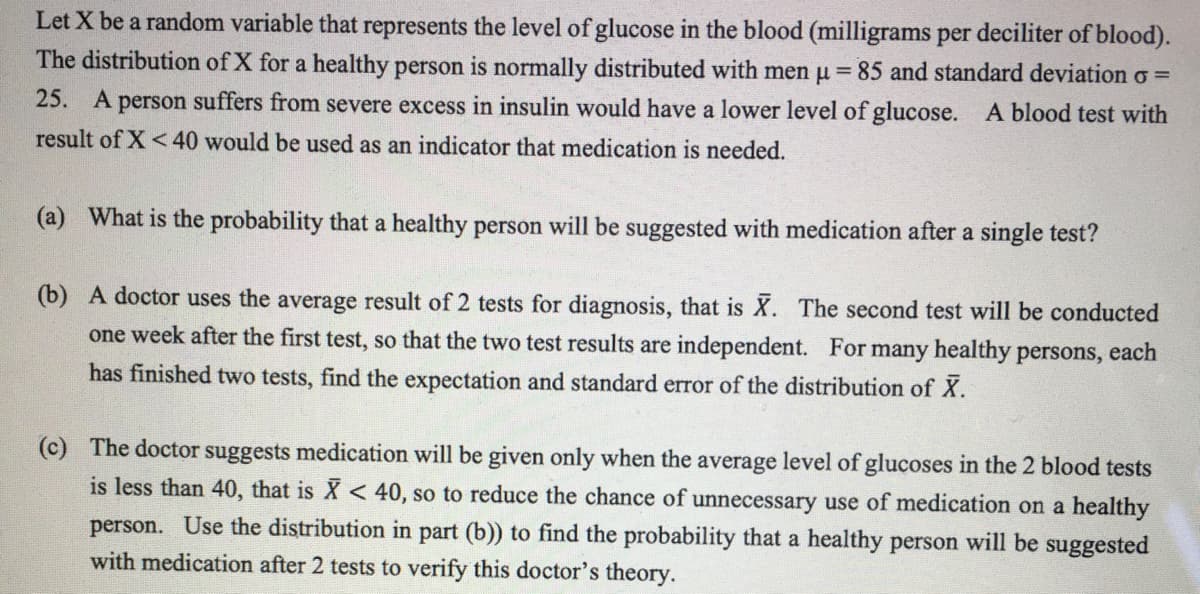Let X be a random variable that represents the level of glucose in the blood (milligrams per deciliter of blood). The distribution of X for a healthy person is normally distributed with men µ= 85 and standard deviation o = 25. A person suffers from severe excess in insulin would have a lower level of glucose. A blood test with result of X<40 would be used as an indicator that medication is needed. (a) What is the probability that a healthy person will be suggested with medication after a single test? (b) A doctor uses the average result of 2 tests for diagnosis, that is X. The second test will be conducted one week after the first test, so that the two test results are independent. For many healthy persons, each has finished two tests, find the expectation and standard error of the distribution of X. (c) The doctor suggests medication will be given only when the average level of glucoses in the 2 blood tests is less than 40, that is X < 40, so to reduce the chance of unnecessary use of medication on a healthy person. Use the distribution in part (b)) to find the probability that a healthy person will be suggested with medication after 2 tests to verify this doctor's theory.
Let X be a random variable that represents the level of glucose in the blood (milligrams per deciliter of blood). The distribution of X for a healthy person is normally distributed with men µ= 85 and standard deviation o = 25. A person suffers from severe excess in insulin would have a lower level of glucose. A blood test with result of X<40 would be used as an indicator that medication is needed. (a) What is the probability that a healthy person will be suggested with medication after a single test? (b) A doctor uses the average result of 2 tests for diagnosis, that is X. The second test will be conducted one week after the first test, so that the two test results are independent. For many healthy persons, each has finished two tests, find the expectation and standard error of the distribution of X. (c) The doctor suggests medication will be given only when the average level of glucoses in the 2 blood tests is less than 40, that is X < 40, so to reduce the chance of unnecessary use of medication on a healthy person. Use the distribution in part (b)) to find the probability that a healthy person will be suggested with medication after 2 tests to verify this doctor's theory.
A First Course in Probability (10th Edition)
10th Edition
ISBN:9780134753119
Author:Sheldon Ross
Publisher:Sheldon Ross
Chapter1: Combinatorial Analysis
Section: Chapter Questions
Problem 1.1P: a. How many different 7-place license plates are possible if the first 2 places are for letters and...
Related questions
Question

Transcribed Image Text:Let X be a random variable that represents the level of glucose in the blood (milligrams per deciliter of blood).
The distribution of X for a healthy person is normally distributed with men µ= 85 and standard deviation o =
25.
A person suffers from severe excess in insulin would have a lower level of glucose. A blood test with
result of X<40 would be used as an indicator that medication is needed.
(a) What is the probability that a healthy person will be suggested with medication after a single test?
(b) A doctor uses the average result of 2 tests for diagnosis, that is X. The second test will be conducted
one week after the first test, so that the two test results are independent. For many healthy persons, each
has finished two tests, find the expectation and standard error of the distribution of X.
(c) The doctor suggests medication will be given only when the average level of glucoses in the 2 blood tests
is less than 40, that is X < 40, so to reduce the chance of unnecessary use of medication on a healthy
person. Use the distribution in part (b)) to find the probability that a healthy person will be suggested
with medication after 2 tests to verify this doctor's theory.
Expert Solution
This question has been solved!
Explore an expertly crafted, step-by-step solution for a thorough understanding of key concepts.
This is a popular solution!
Trending now
This is a popular solution!
Step by step
Solved in 3 steps with 3 images

Recommended textbooks for you

A First Course in Probability (10th Edition)
Probability
ISBN:
9780134753119
Author:
Sheldon Ross
Publisher:
PEARSON


A First Course in Probability (10th Edition)
Probability
ISBN:
9780134753119
Author:
Sheldon Ross
Publisher:
PEARSON
